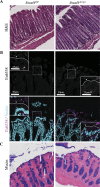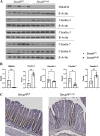Colon epithelial cell TGFβ signaling modulates the expression of tight junction proteins and barrier function in mice
- PMID: 33759564
- PMCID: PMC8285585
- DOI: 10.1152/ajpgi.00053.2021
Colon epithelial cell TGFβ signaling modulates the expression of tight junction proteins and barrier function in mice
Abstract
Defective barrier function is a predisposing factor in inflammatory bowel disease (IBD) and colitis-associated cancer (CAC). Although TGFβ signaling defects have been associated with IBD and CAC, few studies have examined the relationship between TGFβ and intestinal barrier function. Here, we examine the role of TGFβ signaling via SMAD4 in modulation of colon barrier function. The Smad4 gene was conditionally deleted in the intestines of adult mice and intestinal permeability assessed using an in vivo 4 kDa FITC-Dextran (FD4) permeability assay. Mouse colon was isolated for gene expression (RNA-sequencing), Western blot, and immunofluorescence analysis. In vitro colon organoid culture was utilized to assess junction-related gene expression by qPCR and transepithelial resistance (TER). In silico analyses of human IBD and colon cancer databases were performed. Mice lacking intestinal expression of Smad4 demonstrate increased colonic permeability to FD4 without gross mucosal damage. mRNA/protein expression analyses demonstrate significant increases in Cldn2/Claudin 2 and Cldn8/Claudin 8, and decreases in Cldn3, Cldn4, and Cldn7/Claudin 7 with intestinal SMAD4 loss in vivo without changes in Claudin protein localization. TGFβ1/BMP2 treatment of polarized SMAD4+ colonoids increases TER. Cldn2, Cldn4, Cldn7, and Cldn8 are regulated by canonical TGFβ signaling, and TGFβ-dependent regulation of these genes is dependent on nascent RNA transcription (Cldn2, Cldn4, Cldn8) but not nascent protein translation (Cldn4, Cldn8). Human IBD/colon cancer specimens demonstrate decreased SMAD4, CLDN4, CLDN7, and CLDN8 and increased CLDN2 compared with healthy controls. Canonical TGFβ signaling modulates the expression of tight junction proteins and barrier function in mouse colon.NEW & NOTEWORTHY We demonstrate that canonical TGFβ family signaling modulates the expression of critical tight junction proteins in colon epithelial cells, and that expression of these tight junction proteins is associated with maintenance of colon epithelial barrier function in mice.
Keywords: claudin; inflammatory bowel disease; tight junction; transforming growth factor β.
Conflict of interest statement
No conflicts of interest, financial or otherwise, are declared by the authors.
Figures










Similar articles
-
The JAK-Inhibitor Tofacitinib Rescues Human Intestinal Epithelial Cells and Colonoids from Cytokine-Induced Barrier Dysfunction.Inflamm Bowel Dis. 2020 Feb 11;26(3):407-422. doi: 10.1093/ibd/izz266. Inflamm Bowel Dis. 2020. PMID: 31751457 Free PMC article.
-
Effects and Mechanism of Constitutive TL1A Expression on Intestinal Mucosal Barrier in DSS-Induced Colitis.Dig Dis Sci. 2019 Jul;64(7):1844-1856. doi: 10.1007/s10620-019-05580-z. Epub 2019 Apr 4. Dig Dis Sci. 2019. PMID: 30949903
-
Epithelial Smad4 Deletion Up-Regulates Inflammation and Promotes Inflammation-Associated Cancer.Cell Mol Gastroenterol Hepatol. 2018 May 24;6(3):257-276. doi: 10.1016/j.jcmgh.2018.05.006. eCollection 2018. Cell Mol Gastroenterol Hepatol. 2018. PMID: 30109253 Free PMC article.
-
Intestinal Epithelial Tight Junction Barrier Regulation by Novel Pathways.Inflamm Bowel Dis. 2025 Jan 6;31(1):259-271. doi: 10.1093/ibd/izae232. Inflamm Bowel Dis. 2025. PMID: 39321109 Review.
-
Tight junctions in inflammatory bowel diseases and inflammatory bowel disease associated colorectal cancer.World J Gastroenterol. 2016 Mar 21;22(11):3117-26. doi: 10.3748/wjg.v22.i11.3117. World J Gastroenterol. 2016. PMID: 27003989 Free PMC article. Review.
Cited by
-
SMAD4 Suppresses Colitis-associated Carcinoma Through Inhibition of CCL20/CCR6-mediated Inflammation.Gastroenterology. 2022 Nov;163(5):1334-1350.e14. doi: 10.1053/j.gastro.2022.07.016. Epub 2022 Jul 19. Gastroenterology. 2022. PMID: 35863523 Free PMC article.
-
Involvement of Smad7 in Inflammatory Diseases of the Gut and Colon Cancer.Int J Mol Sci. 2021 Apr 10;22(8):3922. doi: 10.3390/ijms22083922. Int J Mol Sci. 2021. PMID: 33920230 Free PMC article. Review.
-
[Moslosooflavone ameliorates dextran sulfate sodium-induced colitis in mice by suppressing intestinal epithelium apoptosis via inhibiting the PI3K/AKT signaling pathway].Nan Fang Yi Ke Da Xue Xue Bao. 2025 Apr 20;45(4):819-828. doi: 10.12122/j.issn.1673-4254.2025.04.17. Nan Fang Yi Ke Da Xue Xue Bao. 2025. PMID: 40294932 Free PMC article. Chinese.
-
Claudin-4: A New Molecular Target for Epithelial Cancer Therapy.Int J Mol Sci. 2023 Mar 13;24(6):5494. doi: 10.3390/ijms24065494. Int J Mol Sci. 2023. PMID: 36982569 Free PMC article. Review.
-
The Expression of the Claudin Family of Proteins in Colorectal Cancer.Biomolecules. 2024 Feb 24;14(3):272. doi: 10.3390/biom14030272. Biomolecules. 2024. PMID: 38540693 Free PMC article. Review.
References
-
- Allaire JM, Darsigny M, Marcoux SS, Roy SAB, Schmouth J-F, Umans L, Zwijsen A, Boudreau F, Perreault N. Loss of Smad5 leads to the disassembly of the apical junctional complex and increased susceptibility to experimental colitis. Am J Physiol Gastrointest Liver Physiol 300: G586–G597, 2011. doi:10.1152/ajpgi.00041.2010. - DOI - PubMed
-
- Sluis M. D, Koning BAED, Bruijn A, Velcich A, Meijerink JPP, Goudoever JBV, Büller HA, Dekker J, Seuningen IV, Renes IB, Einerhand AWC. Muc2-deficient mice spontaneously develop colitis, indicating that MUC2 is critical for colonic protection. Gastroenterology 131: 117–129, 2006. doi:10.1053/j.gastro.2006.04.020. - DOI - PubMed
Publication types
MeSH terms
Substances
Grants and funding
LinkOut - more resources
Full Text Sources
Other Literature Sources
Molecular Biology Databases
Miscellaneous

